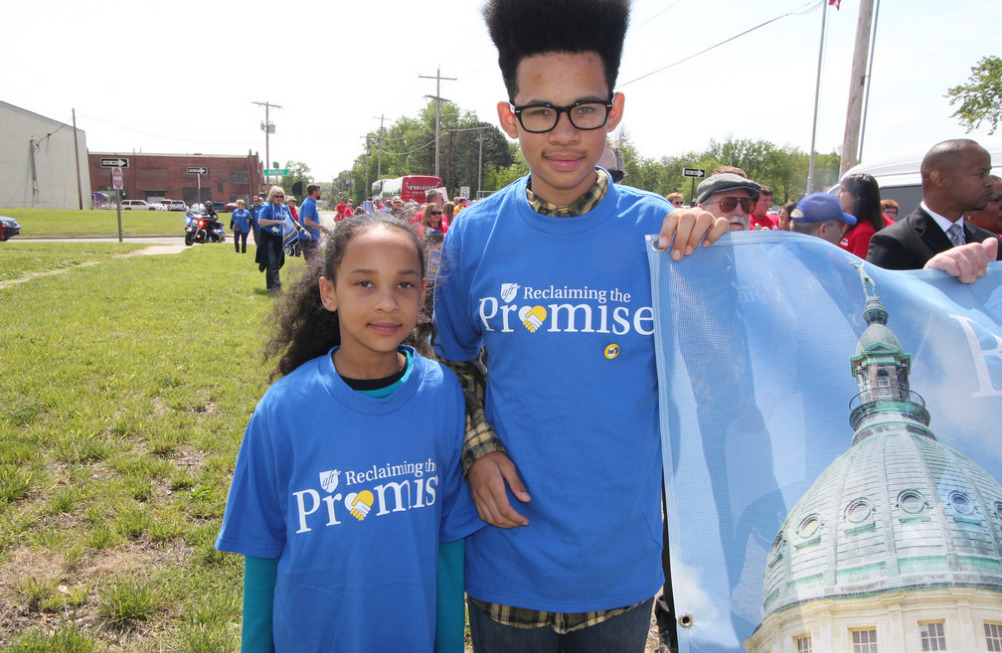 Students attend the rally in Topeka for the 60th anniversary of Brown v Board of Education
Students attend the rally in Topeka for the 60th anniversary of Brown v Board of Education
Bleeding Kansas
By Muna Mire
This past week, the state of Kansas captured the attention of the nation and the news cycle as the 60th anniversary of Brown v. Board of Education, a case which made the Topeka Board of Education famous, touched off a long-overdue conversation around the legacy of American public education. In the same year that we saw a nostalgic remembering of past civil rights battles like the 50th anniversary of the March on Washington, the act of remembering Brown felt very different.
Many were rightfully critical of the 50th anniversary March on Washington celebrations, and their criticisms reside in the gap between the legacy of the movement and where it stands today. At the 50th anniversary celebrations, protest placards were seized by police that read “Stop Mass Incarceration. Stop the New Jim Crow.” It was more important to prioritize keeping the peace and maintaining the appearance of harmony at the event than it was to do the work of eliminating racial inequality.
With the anniversary of Brown, there was no question that such a gap exists. No one was trying to maintain the image of Kansas public schools as equitable; it’s clear that America’s public school system is at war.
Kansas is a battleground.
Kansas governor Sam Brownback’s name has been invoked often over the course of the last week and in conversations around public education. Brownback’s Kansas is one that mainstream media has repeatedly referred to as a “laboratory for Tea Party policy.” Bankrolled by Koch Industries, the American Legislative Exchange Council and their model legislation approach to policy has had a profound impact on Kansas politics. What we are witnessing is a direct result of the influence of these two billionaires.
Brownback’s experiments in small government have resulted in massive cuts across public education and social services, while also pushing unprecedented income tax cuts and giving tax credits to corporations that fund private school scholarships for at-risk youth. Austerity is starving public schools that serve Black and Brown kids, only for the state of Kansas to turn around and claim that these schools (and teachers) aren’t up to standard. In its ruling against Brownback, the Supreme Court of Kansas said that “it seems completely illogical that the state can argue that a reduction in education funding was necessitated by the downturn in the economy and the state’s diminishing resources and at the same time cut taxes further.”
Brownback has since flouted the powers of the state Supreme Court.
Last Saturday, May 17th, Topeka’s capitol building was the site of a rally co-organized by the American Federation of Teachers (AFT) and the Kansas National Education Association, the largest teachers’ union in the state. The rally was planned in order to bring attention to the fact that on the 60th anniversary of one of the most important legal decisions in the history of the U.S., the public school system is under attack from hostile governors and state legislatures, the tide of privatization and charter schools, and secretive, proprietary teacher evaluation standards to name a few.
While Brown v. Board of Education unanimously decreed against school segregation, schools in America, and ironically, schools in Kansas in particular, are sadly increasingly segregated along racial lines. What’s more, the same trend that sees America’s crumbling public school system occupied nearly exclusively by Black and Brown youth has also ensured that these poor school districts – often in urban areas – do not receive equitable funding from the state. The Kansas Supreme Court recently found as much, and ordered the governor to rectify the situation with poorer school districts like Topeka, where 77% of students qualify for free or reduced lunch.
The rally was attended by several hundred people who marched from the Brown v. Board of Education National Historic Site to the capitol. The crowd was made up of teachers, students, advocates, faith leaders, and concerned community members. Randi Weingarten, president of the AFT; Lucinda Noches Talbert, granddaughter of original plaintiff; and local NAACP leader Rev. Dr. Rodney Williams were among those speaking.
Weingarten, who took a moment to speak with {Young}ist, underscored how critical Saturday’s protest was, explaining that Kansas is ground zero for a battle taking place across the nation.
“In America, public education is the anchor of our democracy, the propeller of our economy, and our guidepost for ensuring that all children have equal access to opportunity,” she said.
Weingarten explained that all children can climb the ladder of educational opportunity, not just when we advocate for them, but when we deploy proven strategies to make our vision for public education real. She believes having well-prepared, well-supported, and fairly evaluated teachers is critical. So is a curriculum that encourages a diversity of subjects, including arts and music education and access to the same mentoring and support that wealthier students access.
“If we think this stuff is important for rich kids, it’s more important for poor kids,” said Weingarten.
Eleven-year-old Lindsay Baltzell, a 5th-grade student in Topeka’s Shawnee Heights district who also spoke at the rally, agrees with Weingarten and believes that lawmakers should check in with kids every once in a while.
“They can get a perspective on how a younger person feels about all these things and that helps them in making decisions,” Baltzell told {Young}ist.
Of the disparities across school districts, Lindsay said she knows that although her specific school isn’t the worst off in the district, she has friends that attend schools where the funding cuts have had a much more of an impact. Lindsay would like to see lawmakers and other officials prioritize reversing or at least ameliorating the impact of the cuts on school supports for anti-bullying programs and the arts.
“There are schools that are smaller than mine that don’t have some of the classes that I have,” she said.
For Weingarten, equity is critically important in any conversation around public schools. Poverty and housing discrimination are real problems tangential to and occasionally overlapping with questions of inequity in public schooling. The solution? Wraparound services that attack the problem at the root rather than blame the victims for failing to perform. Statistics have shownthat simply eating a meal for breakfast improves test scores significantly.
In a district like Topeka, where the vast majority of students qualify for free or reduced lunch (a traditional indicator of poverty), wraparound services that go beyond the basics like food – and are tailored to the needs of individual students – are needed. Wraparound services are the result of partnerships between local community organizations and schools that work to “complement and align with effective instruction” according to the NEA. These can include comprehensive healthcare (including dental and mental health), mentorship and advocacy, tutoring and after school programming, and nutritional programs.
In Cincinnati, Weingarten points to the example of a 50-80 percent jump in graduation rates in a high-poverty district thanks to wraparound services provided by the school and larger community.
“What Brown did sixty years ago was to say that in order to get there we needed to end legal segregation. Today, in order to get there we need to fixate on equity. Equity is the path to excellence. Because with the increasing gap between rich and poor, what you see is that kids who go to middle class schools have more opportunity than kids who don’t,” said Weingarten.
Also present at Saturday’s events was granddaughter of the original plaintiff in the Brown v. Board of Education case, Lucinda Noches Talbert.
Talbert told {Young}ist that “the tax cuts are starting to impact the ability of our schools to be properly resourced.” She believes Brownback’s agenda has devastated the public school system in her state.
“We know that children from lower income communities need services in order to have a successful academic career and with these austere tax cuts not only are we not going to be able to move forward on that goal, we’re moving backwards. It’s a step in the wrong direction and we need to rectify it,” she said.
When asked what she thought of Brown’s legacy given the situation in Kansas today, Talbert did not mince words.
“What it means is that we have taken our eyes off the ball, so to speak, and we have yet to realize my grandmother’s dream of equitable educational opportunities for all children regardless of race or income or economic circumstances.”
Muna Mire
Organizer, Writer, Black girl from the future.
Catch up with me @Muna_Mire.

